MMM240 Organisational Behaviour Reflective Journal Assignment
VerifiedAdded on 2022/08/22
|9
|2840
|9
Journal and Reflective Writing
AI Summary
This reflective journal assignment for MMM240 explores key concepts in organisational behaviour through four journal entries. The first entry focuses on motivating the contemporary workforce, discussing internal and external theories of motivation, cultural differences, and the importance of career development and a positive work environment. The second entry examines working and performing in groups and teams, analyzing the benefits of collaboration and the stages of team development, while also acknowledging the drawbacks of groupthink. The third entry delves into leadership in the 21st century, comparing different leadership styles such as transformational, democratic, autocratic, and laissez-faire. The final entry provides a professional identity self-reflection, detailing the student's skills, experiences, and aspirations as an HR manager, highlighting communication, teamwork, and adaptability. The assignment integrates theoretical knowledge with practical experiences and offers critical reflections on organisational behaviour issues.
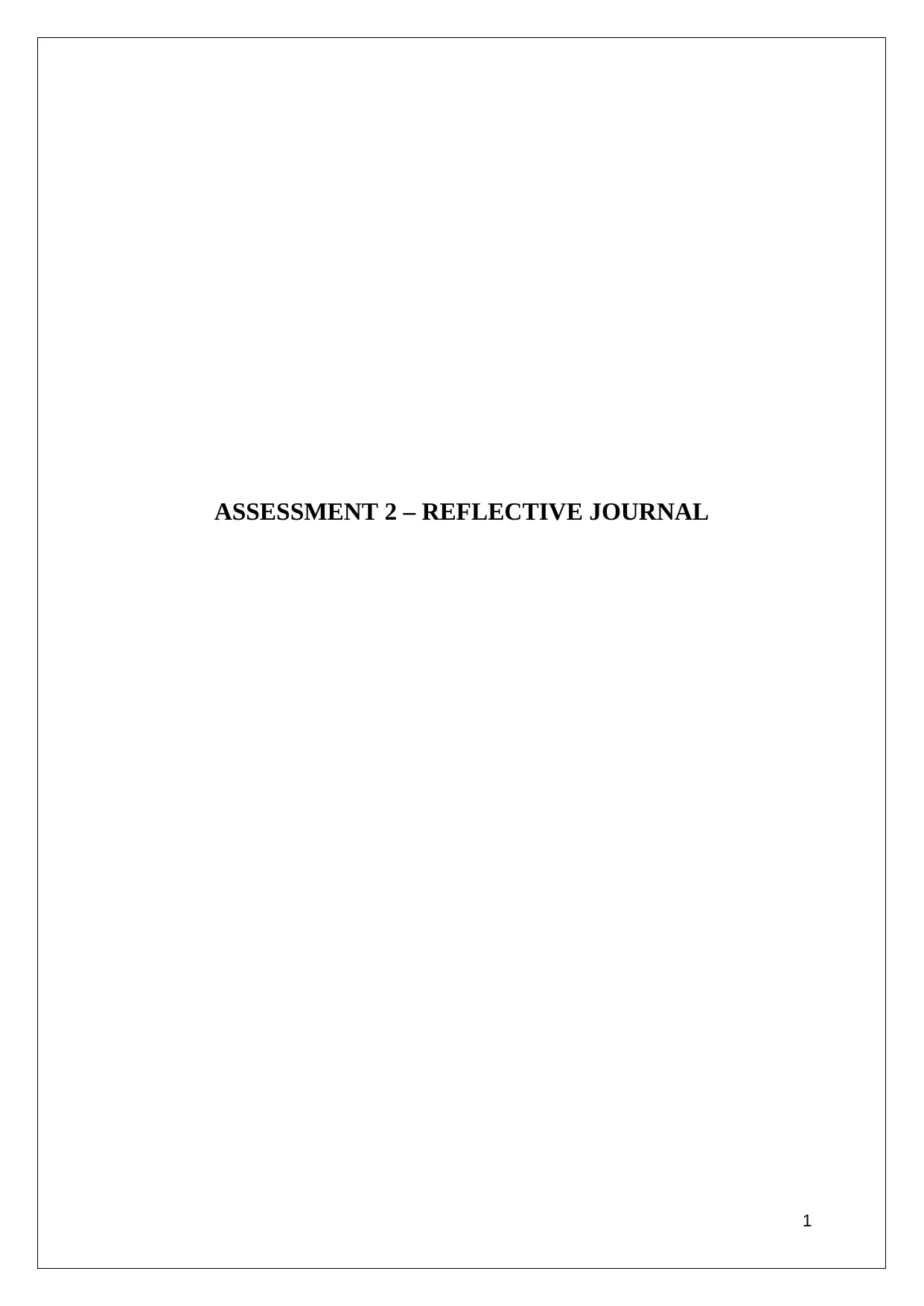
ASSESSMENT 2 – REFLECTIVE JOURNAL
1
1
Paraphrase This Document
Need a fresh take? Get an instant paraphrase of this document with our AI Paraphraser
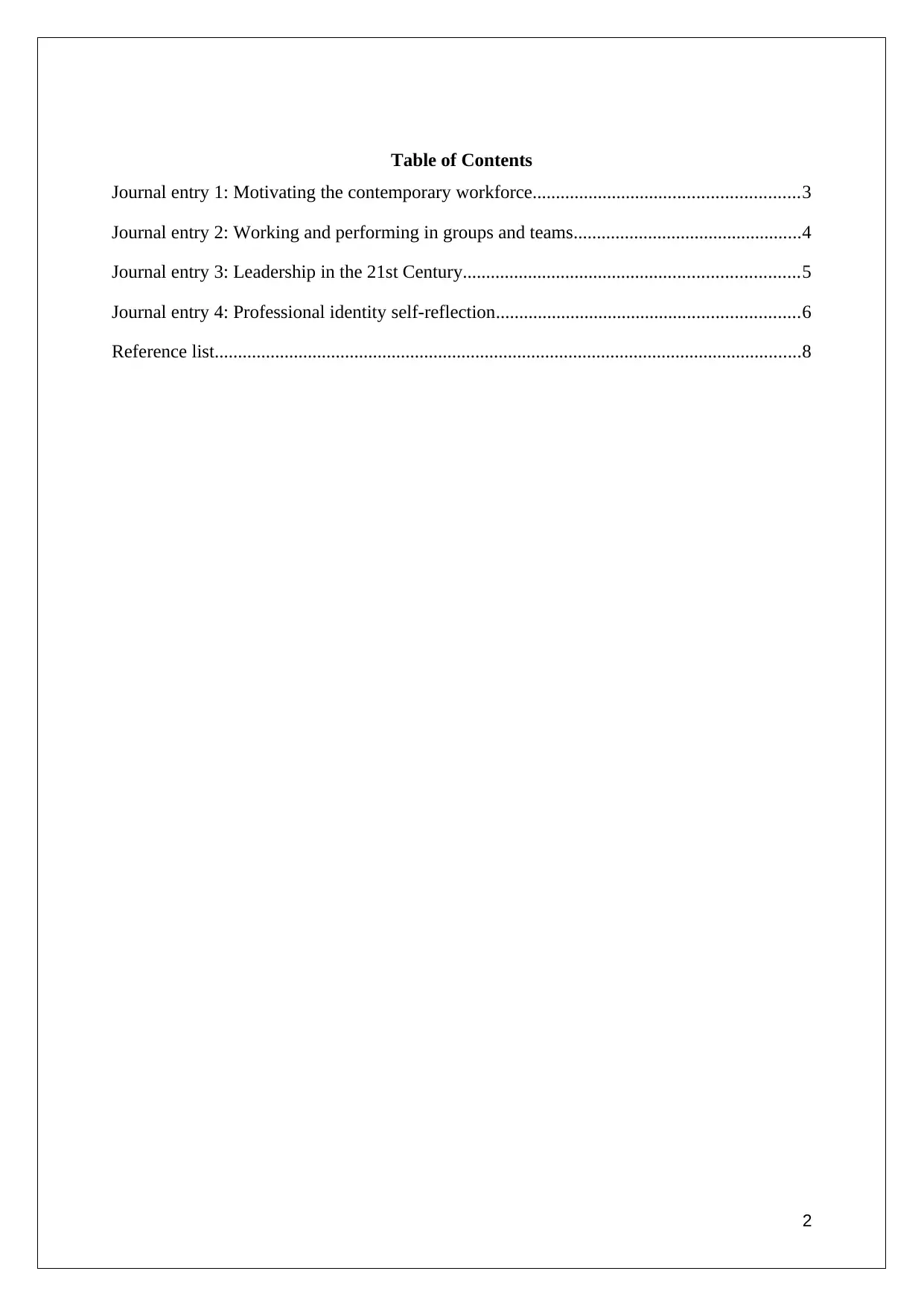
Table of Contents
Journal entry 1: Motivating the contemporary workforce.........................................................3
Journal entry 2: Working and performing in groups and teams.................................................4
Journal entry 3: Leadership in the 21st Century........................................................................5
Journal entry 4: Professional identity self-reflection.................................................................6
Reference list..............................................................................................................................8
2
Journal entry 1: Motivating the contemporary workforce.........................................................3
Journal entry 2: Working and performing in groups and teams.................................................4
Journal entry 3: Leadership in the 21st Century........................................................................5
Journal entry 4: Professional identity self-reflection.................................................................6
Reference list..............................................................................................................................8
2
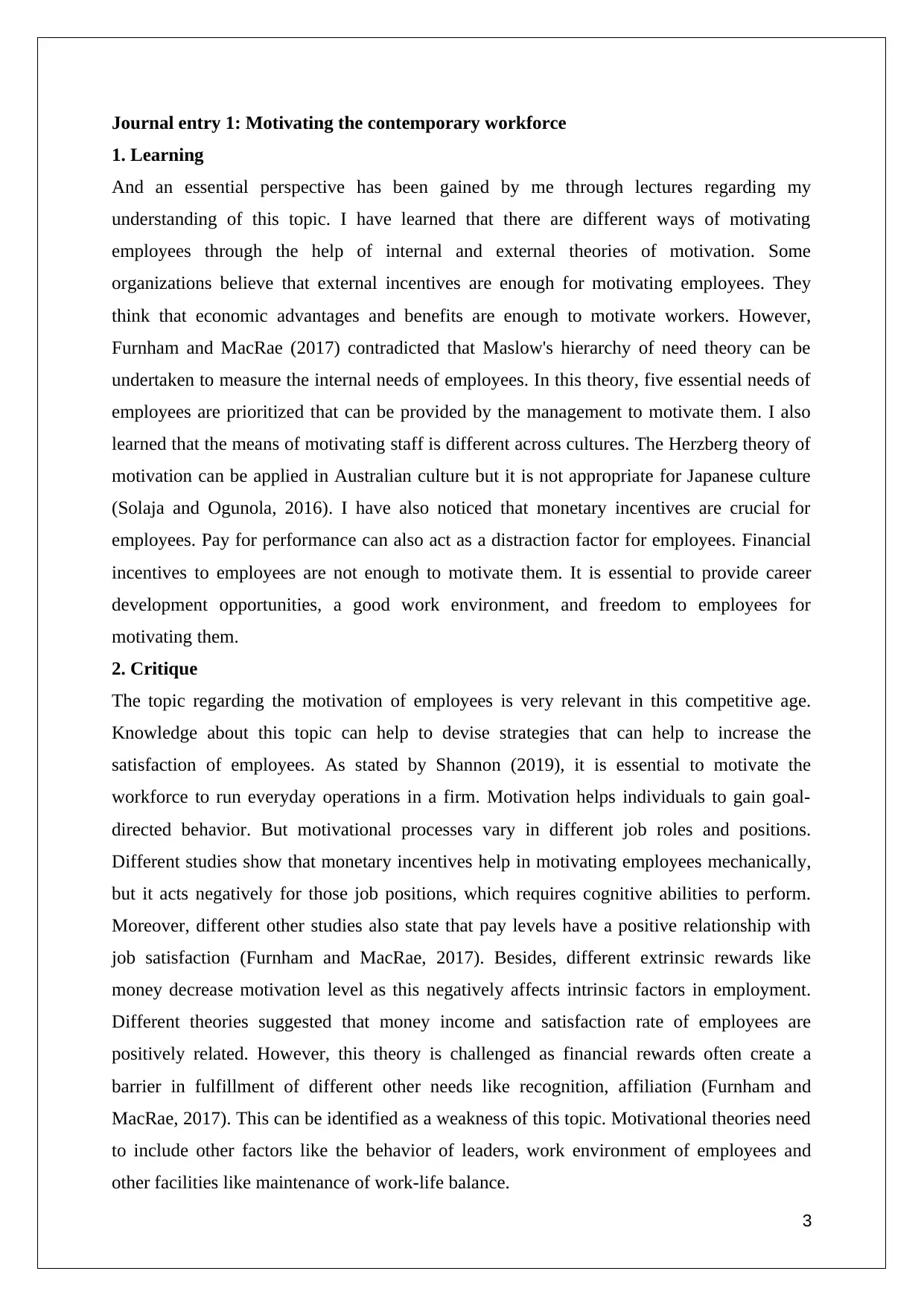
Journal entry 1: Motivating the contemporary workforce
1. Learning
And an essential perspective has been gained by me through lectures regarding my
understanding of this topic. I have learned that there are different ways of motivating
employees through the help of internal and external theories of motivation. Some
organizations believe that external incentives are enough for motivating employees. They
think that economic advantages and benefits are enough to motivate workers. However,
Furnham and MacRae (2017) contradicted that Maslow's hierarchy of need theory can be
undertaken to measure the internal needs of employees. In this theory, five essential needs of
employees are prioritized that can be provided by the management to motivate them. I also
learned that the means of motivating staff is different across cultures. The Herzberg theory of
motivation can be applied in Australian culture but it is not appropriate for Japanese culture
(Solaja and Ogunola, 2016). I have also noticed that monetary incentives are crucial for
employees. Pay for performance can also act as a distraction factor for employees. Financial
incentives to employees are not enough to motivate them. It is essential to provide career
development opportunities, a good work environment, and freedom to employees for
motivating them.
2. Critique
The topic regarding the motivation of employees is very relevant in this competitive age.
Knowledge about this topic can help to devise strategies that can help to increase the
satisfaction of employees. As stated by Shannon (2019), it is essential to motivate the
workforce to run everyday operations in a firm. Motivation helps individuals to gain goal-
directed behavior. But motivational processes vary in different job roles and positions.
Different studies show that monetary incentives help in motivating employees mechanically,
but it acts negatively for those job positions, which requires cognitive abilities to perform.
Moreover, different other studies also state that pay levels have a positive relationship with
job satisfaction (Furnham and MacRae, 2017). Besides, different extrinsic rewards like
money decrease motivation level as this negatively affects intrinsic factors in employment.
Different theories suggested that money income and satisfaction rate of employees are
positively related. However, this theory is challenged as financial rewards often create a
barrier in fulfillment of different other needs like recognition, affiliation (Furnham and
MacRae, 2017). This can be identified as a weakness of this topic. Motivational theories need
to include other factors like the behavior of leaders, work environment of employees and
other facilities like maintenance of work-life balance.
3
1. Learning
And an essential perspective has been gained by me through lectures regarding my
understanding of this topic. I have learned that there are different ways of motivating
employees through the help of internal and external theories of motivation. Some
organizations believe that external incentives are enough for motivating employees. They
think that economic advantages and benefits are enough to motivate workers. However,
Furnham and MacRae (2017) contradicted that Maslow's hierarchy of need theory can be
undertaken to measure the internal needs of employees. In this theory, five essential needs of
employees are prioritized that can be provided by the management to motivate them. I also
learned that the means of motivating staff is different across cultures. The Herzberg theory of
motivation can be applied in Australian culture but it is not appropriate for Japanese culture
(Solaja and Ogunola, 2016). I have also noticed that monetary incentives are crucial for
employees. Pay for performance can also act as a distraction factor for employees. Financial
incentives to employees are not enough to motivate them. It is essential to provide career
development opportunities, a good work environment, and freedom to employees for
motivating them.
2. Critique
The topic regarding the motivation of employees is very relevant in this competitive age.
Knowledge about this topic can help to devise strategies that can help to increase the
satisfaction of employees. As stated by Shannon (2019), it is essential to motivate the
workforce to run everyday operations in a firm. Motivation helps individuals to gain goal-
directed behavior. But motivational processes vary in different job roles and positions.
Different studies show that monetary incentives help in motivating employees mechanically,
but it acts negatively for those job positions, which requires cognitive abilities to perform.
Moreover, different other studies also state that pay levels have a positive relationship with
job satisfaction (Furnham and MacRae, 2017). Besides, different extrinsic rewards like
money decrease motivation level as this negatively affects intrinsic factors in employment.
Different theories suggested that money income and satisfaction rate of employees are
positively related. However, this theory is challenged as financial rewards often create a
barrier in fulfillment of different other needs like recognition, affiliation (Furnham and
MacRae, 2017). This can be identified as a weakness of this topic. Motivational theories need
to include other factors like the behavior of leaders, work environment of employees and
other facilities like maintenance of work-life balance.
3
⊘ This is a preview!⊘
Do you want full access?
Subscribe today to unlock all pages.

Trusted by 1+ million students worldwide
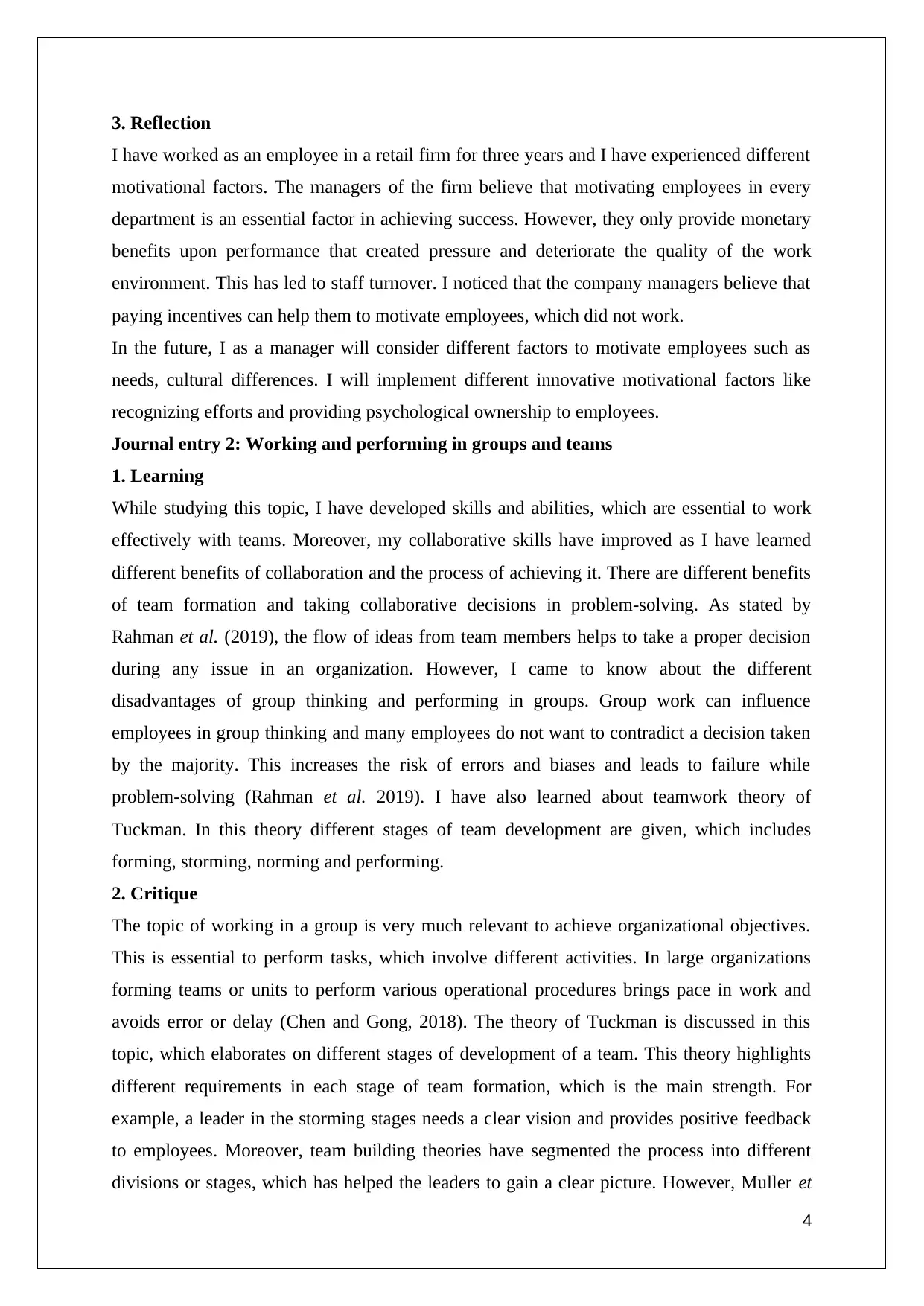
3. Reflection
I have worked as an employee in a retail firm for three years and I have experienced different
motivational factors. The managers of the firm believe that motivating employees in every
department is an essential factor in achieving success. However, they only provide monetary
benefits upon performance that created pressure and deteriorate the quality of the work
environment. This has led to staff turnover. I noticed that the company managers believe that
paying incentives can help them to motivate employees, which did not work.
In the future, I as a manager will consider different factors to motivate employees such as
needs, cultural differences. I will implement different innovative motivational factors like
recognizing efforts and providing psychological ownership to employees.
Journal entry 2: Working and performing in groups and teams
1. Learning
While studying this topic, I have developed skills and abilities, which are essential to work
effectively with teams. Moreover, my collaborative skills have improved as I have learned
different benefits of collaboration and the process of achieving it. There are different benefits
of team formation and taking collaborative decisions in problem-solving. As stated by
Rahman et al. (2019), the flow of ideas from team members helps to take a proper decision
during any issue in an organization. However, I came to know about the different
disadvantages of group thinking and performing in groups. Group work can influence
employees in group thinking and many employees do not want to contradict a decision taken
by the majority. This increases the risk of errors and biases and leads to failure while
problem-solving (Rahman et al. 2019). I have also learned about teamwork theory of
Tuckman. In this theory different stages of team development are given, which includes
forming, storming, norming and performing.
2. Critique
The topic of working in a group is very much relevant to achieve organizational objectives.
This is essential to perform tasks, which involve different activities. In large organizations
forming teams or units to perform various operational procedures brings pace in work and
avoids error or delay (Chen and Gong, 2018). The theory of Tuckman is discussed in this
topic, which elaborates on different stages of development of a team. This theory highlights
different requirements in each stage of team formation, which is the main strength. For
example, a leader in the storming stages needs a clear vision and provides positive feedback
to employees. Moreover, team building theories have segmented the process into different
divisions or stages, which has helped the leaders to gain a clear picture. However, Muller et
4
I have worked as an employee in a retail firm for three years and I have experienced different
motivational factors. The managers of the firm believe that motivating employees in every
department is an essential factor in achieving success. However, they only provide monetary
benefits upon performance that created pressure and deteriorate the quality of the work
environment. This has led to staff turnover. I noticed that the company managers believe that
paying incentives can help them to motivate employees, which did not work.
In the future, I as a manager will consider different factors to motivate employees such as
needs, cultural differences. I will implement different innovative motivational factors like
recognizing efforts and providing psychological ownership to employees.
Journal entry 2: Working and performing in groups and teams
1. Learning
While studying this topic, I have developed skills and abilities, which are essential to work
effectively with teams. Moreover, my collaborative skills have improved as I have learned
different benefits of collaboration and the process of achieving it. There are different benefits
of team formation and taking collaborative decisions in problem-solving. As stated by
Rahman et al. (2019), the flow of ideas from team members helps to take a proper decision
during any issue in an organization. However, I came to know about the different
disadvantages of group thinking and performing in groups. Group work can influence
employees in group thinking and many employees do not want to contradict a decision taken
by the majority. This increases the risk of errors and biases and leads to failure while
problem-solving (Rahman et al. 2019). I have also learned about teamwork theory of
Tuckman. In this theory different stages of team development are given, which includes
forming, storming, norming and performing.
2. Critique
The topic of working in a group is very much relevant to achieve organizational objectives.
This is essential to perform tasks, which involve different activities. In large organizations
forming teams or units to perform various operational procedures brings pace in work and
avoids error or delay (Chen and Gong, 2018). The theory of Tuckman is discussed in this
topic, which elaborates on different stages of development of a team. This theory highlights
different requirements in each stage of team formation, which is the main strength. For
example, a leader in the storming stages needs a clear vision and provides positive feedback
to employees. Moreover, team building theories have segmented the process into different
divisions or stages, which has helped the leaders to gain a clear picture. However, Muller et
4
Paraphrase This Document
Need a fresh take? Get an instant paraphrase of this document with our AI Paraphraser
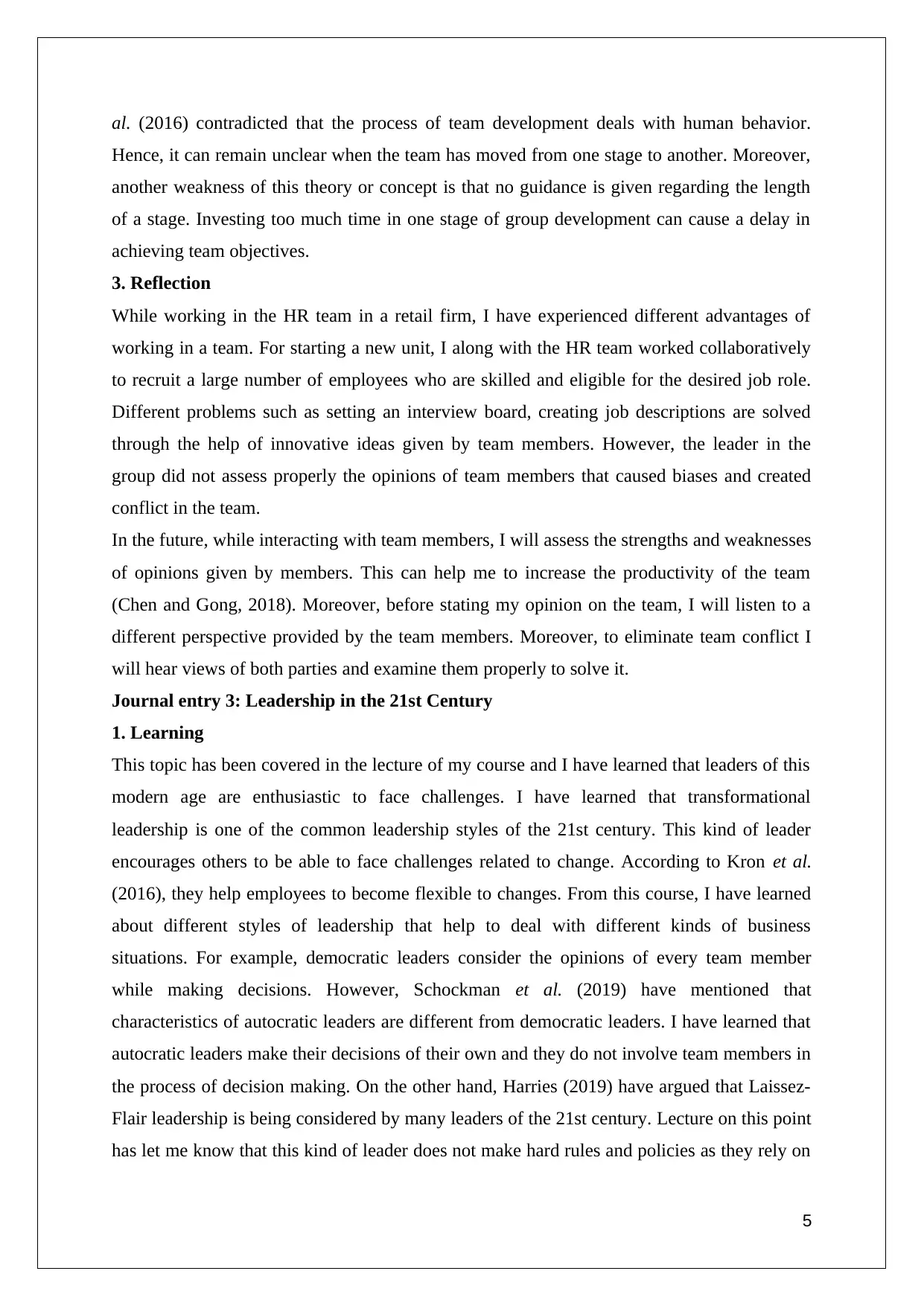
al. (2016) contradicted that the process of team development deals with human behavior.
Hence, it can remain unclear when the team has moved from one stage to another. Moreover,
another weakness of this theory or concept is that no guidance is given regarding the length
of a stage. Investing too much time in one stage of group development can cause a delay in
achieving team objectives.
3. Reflection
While working in the HR team in a retail firm, I have experienced different advantages of
working in a team. For starting a new unit, I along with the HR team worked collaboratively
to recruit a large number of employees who are skilled and eligible for the desired job role.
Different problems such as setting an interview board, creating job descriptions are solved
through the help of innovative ideas given by team members. However, the leader in the
group did not assess properly the opinions of team members that caused biases and created
conflict in the team.
In the future, while interacting with team members, I will assess the strengths and weaknesses
of opinions given by members. This can help me to increase the productivity of the team
(Chen and Gong, 2018). Moreover, before stating my opinion on the team, I will listen to a
different perspective provided by the team members. Moreover, to eliminate team conflict I
will hear views of both parties and examine them properly to solve it.
Journal entry 3: Leadership in the 21st Century
1. Learning
This topic has been covered in the lecture of my course and I have learned that leaders of this
modern age are enthusiastic to face challenges. I have learned that transformational
leadership is one of the common leadership styles of the 21st century. This kind of leader
encourages others to be able to face challenges related to change. According to Kron et al.
(2016), they help employees to become flexible to changes. From this course, I have learned
about different styles of leadership that help to deal with different kinds of business
situations. For example, democratic leaders consider the opinions of every team member
while making decisions. However, Schockman et al. (2019) have mentioned that
characteristics of autocratic leaders are different from democratic leaders. I have learned that
autocratic leaders make their decisions of their own and they do not involve team members in
the process of decision making. On the other hand, Harries (2019) have argued that Laissez-
Flair leadership is being considered by many leaders of the 21st century. Lecture on this point
has let me know that this kind of leader does not make hard rules and policies as they rely on
5
Hence, it can remain unclear when the team has moved from one stage to another. Moreover,
another weakness of this theory or concept is that no guidance is given regarding the length
of a stage. Investing too much time in one stage of group development can cause a delay in
achieving team objectives.
3. Reflection
While working in the HR team in a retail firm, I have experienced different advantages of
working in a team. For starting a new unit, I along with the HR team worked collaboratively
to recruit a large number of employees who are skilled and eligible for the desired job role.
Different problems such as setting an interview board, creating job descriptions are solved
through the help of innovative ideas given by team members. However, the leader in the
group did not assess properly the opinions of team members that caused biases and created
conflict in the team.
In the future, while interacting with team members, I will assess the strengths and weaknesses
of opinions given by members. This can help me to increase the productivity of the team
(Chen and Gong, 2018). Moreover, before stating my opinion on the team, I will listen to a
different perspective provided by the team members. Moreover, to eliminate team conflict I
will hear views of both parties and examine them properly to solve it.
Journal entry 3: Leadership in the 21st Century
1. Learning
This topic has been covered in the lecture of my course and I have learned that leaders of this
modern age are enthusiastic to face challenges. I have learned that transformational
leadership is one of the common leadership styles of the 21st century. This kind of leader
encourages others to be able to face challenges related to change. According to Kron et al.
(2016), they help employees to become flexible to changes. From this course, I have learned
about different styles of leadership that help to deal with different kinds of business
situations. For example, democratic leaders consider the opinions of every team member
while making decisions. However, Schockman et al. (2019) have mentioned that
characteristics of autocratic leaders are different from democratic leaders. I have learned that
autocratic leaders make their decisions of their own and they do not involve team members in
the process of decision making. On the other hand, Harries (2019) have argued that Laissez-
Flair leadership is being considered by many leaders of the 21st century. Lecture on this point
has let me know that this kind of leader does not make hard rules and policies as they rely on
5
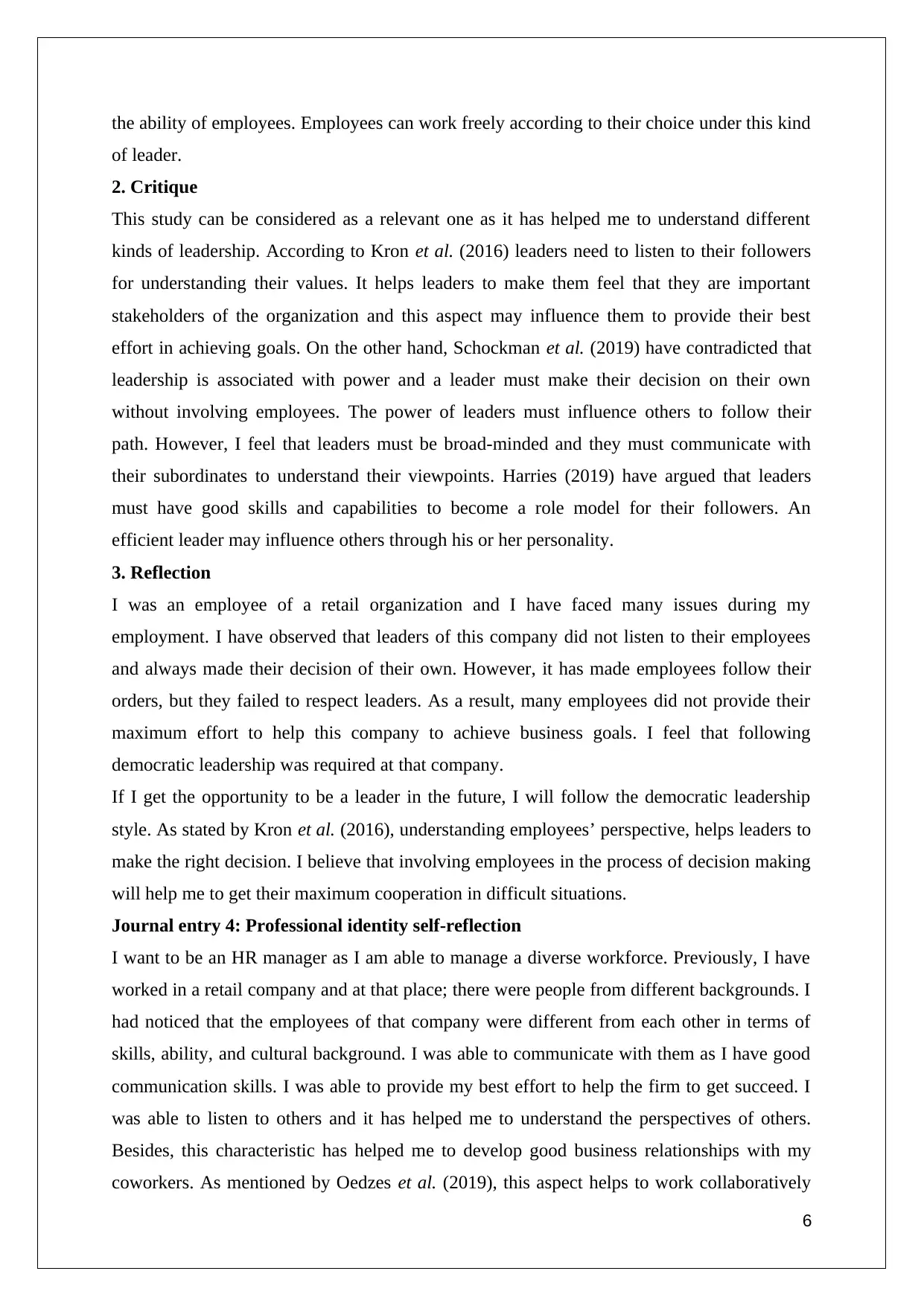
the ability of employees. Employees can work freely according to their choice under this kind
of leader.
2. Critique
This study can be considered as a relevant one as it has helped me to understand different
kinds of leadership. According to Kron et al. (2016) leaders need to listen to their followers
for understanding their values. It helps leaders to make them feel that they are important
stakeholders of the organization and this aspect may influence them to provide their best
effort in achieving goals. On the other hand, Schockman et al. (2019) have contradicted that
leadership is associated with power and a leader must make their decision on their own
without involving employees. The power of leaders must influence others to follow their
path. However, I feel that leaders must be broad-minded and they must communicate with
their subordinates to understand their viewpoints. Harries (2019) have argued that leaders
must have good skills and capabilities to become a role model for their followers. An
efficient leader may influence others through his or her personality.
3. Reflection
I was an employee of a retail organization and I have faced many issues during my
employment. I have observed that leaders of this company did not listen to their employees
and always made their decision of their own. However, it has made employees follow their
orders, but they failed to respect leaders. As a result, many employees did not provide their
maximum effort to help this company to achieve business goals. I feel that following
democratic leadership was required at that company.
If I get the opportunity to be a leader in the future, I will follow the democratic leadership
style. As stated by Kron et al. (2016), understanding employees’ perspective, helps leaders to
make the right decision. I believe that involving employees in the process of decision making
will help me to get their maximum cooperation in difficult situations.
Journal entry 4: Professional identity self-reflection
I want to be an HR manager as I am able to manage a diverse workforce. Previously, I have
worked in a retail company and at that place; there were people from different backgrounds. I
had noticed that the employees of that company were different from each other in terms of
skills, ability, and cultural background. I was able to communicate with them as I have good
communication skills. I was able to provide my best effort to help the firm to get succeed. I
was able to listen to others and it has helped me to understand the perspectives of others.
Besides, this characteristic has helped me to develop good business relationships with my
coworkers. As mentioned by Oedzes et al. (2019), this aspect helps to work collaboratively
6
of leader.
2. Critique
This study can be considered as a relevant one as it has helped me to understand different
kinds of leadership. According to Kron et al. (2016) leaders need to listen to their followers
for understanding their values. It helps leaders to make them feel that they are important
stakeholders of the organization and this aspect may influence them to provide their best
effort in achieving goals. On the other hand, Schockman et al. (2019) have contradicted that
leadership is associated with power and a leader must make their decision on their own
without involving employees. The power of leaders must influence others to follow their
path. However, I feel that leaders must be broad-minded and they must communicate with
their subordinates to understand their viewpoints. Harries (2019) have argued that leaders
must have good skills and capabilities to become a role model for their followers. An
efficient leader may influence others through his or her personality.
3. Reflection
I was an employee of a retail organization and I have faced many issues during my
employment. I have observed that leaders of this company did not listen to their employees
and always made their decision of their own. However, it has made employees follow their
orders, but they failed to respect leaders. As a result, many employees did not provide their
maximum effort to help this company to achieve business goals. I feel that following
democratic leadership was required at that company.
If I get the opportunity to be a leader in the future, I will follow the democratic leadership
style. As stated by Kron et al. (2016), understanding employees’ perspective, helps leaders to
make the right decision. I believe that involving employees in the process of decision making
will help me to get their maximum cooperation in difficult situations.
Journal entry 4: Professional identity self-reflection
I want to be an HR manager as I am able to manage a diverse workforce. Previously, I have
worked in a retail company and at that place; there were people from different backgrounds. I
had noticed that the employees of that company were different from each other in terms of
skills, ability, and cultural background. I was able to communicate with them as I have good
communication skills. I was able to provide my best effort to help the firm to get succeed. I
was able to listen to others and it has helped me to understand the perspectives of others.
Besides, this characteristic has helped me to develop good business relationships with my
coworkers. As mentioned by Oedzes et al. (2019), this aspect helps to work collaboratively
6
⊘ This is a preview!⊘
Do you want full access?
Subscribe today to unlock all pages.

Trusted by 1+ million students worldwide
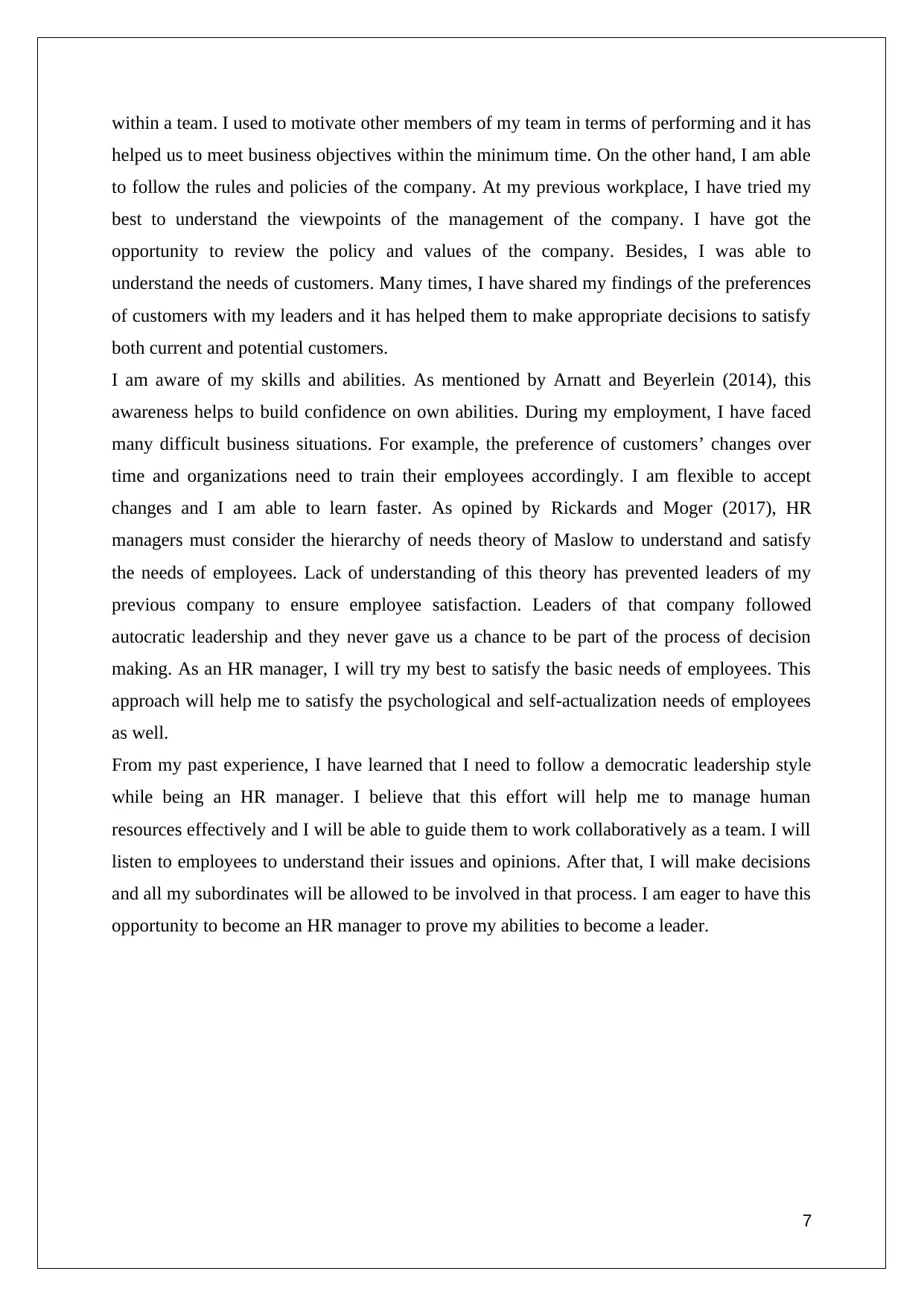
within a team. I used to motivate other members of my team in terms of performing and it has
helped us to meet business objectives within the minimum time. On the other hand, I am able
to follow the rules and policies of the company. At my previous workplace, I have tried my
best to understand the viewpoints of the management of the company. I have got the
opportunity to review the policy and values of the company. Besides, I was able to
understand the needs of customers. Many times, I have shared my findings of the preferences
of customers with my leaders and it has helped them to make appropriate decisions to satisfy
both current and potential customers.
I am aware of my skills and abilities. As mentioned by Arnatt and Beyerlein (2014), this
awareness helps to build confidence on own abilities. During my employment, I have faced
many difficult business situations. For example, the preference of customers’ changes over
time and organizations need to train their employees accordingly. I am flexible to accept
changes and I am able to learn faster. As opined by Rickards and Moger (2017), HR
managers must consider the hierarchy of needs theory of Maslow to understand and satisfy
the needs of employees. Lack of understanding of this theory has prevented leaders of my
previous company to ensure employee satisfaction. Leaders of that company followed
autocratic leadership and they never gave us a chance to be part of the process of decision
making. As an HR manager, I will try my best to satisfy the basic needs of employees. This
approach will help me to satisfy the psychological and self-actualization needs of employees
as well.
From my past experience, I have learned that I need to follow a democratic leadership style
while being an HR manager. I believe that this effort will help me to manage human
resources effectively and I will be able to guide them to work collaboratively as a team. I will
listen to employees to understand their issues and opinions. After that, I will make decisions
and all my subordinates will be allowed to be involved in that process. I am eager to have this
opportunity to become an HR manager to prove my abilities to become a leader.
7
helped us to meet business objectives within the minimum time. On the other hand, I am able
to follow the rules and policies of the company. At my previous workplace, I have tried my
best to understand the viewpoints of the management of the company. I have got the
opportunity to review the policy and values of the company. Besides, I was able to
understand the needs of customers. Many times, I have shared my findings of the preferences
of customers with my leaders and it has helped them to make appropriate decisions to satisfy
both current and potential customers.
I am aware of my skills and abilities. As mentioned by Arnatt and Beyerlein (2014), this
awareness helps to build confidence on own abilities. During my employment, I have faced
many difficult business situations. For example, the preference of customers’ changes over
time and organizations need to train their employees accordingly. I am flexible to accept
changes and I am able to learn faster. As opined by Rickards and Moger (2017), HR
managers must consider the hierarchy of needs theory of Maslow to understand and satisfy
the needs of employees. Lack of understanding of this theory has prevented leaders of my
previous company to ensure employee satisfaction. Leaders of that company followed
autocratic leadership and they never gave us a chance to be part of the process of decision
making. As an HR manager, I will try my best to satisfy the basic needs of employees. This
approach will help me to satisfy the psychological and self-actualization needs of employees
as well.
From my past experience, I have learned that I need to follow a democratic leadership style
while being an HR manager. I believe that this effort will help me to manage human
resources effectively and I will be able to guide them to work collaboratively as a team. I will
listen to employees to understand their issues and opinions. After that, I will make decisions
and all my subordinates will be allowed to be involved in that process. I am eager to have this
opportunity to become an HR manager to prove my abilities to become a leader.
7
Paraphrase This Document
Need a fresh take? Get an instant paraphrase of this document with our AI Paraphraser
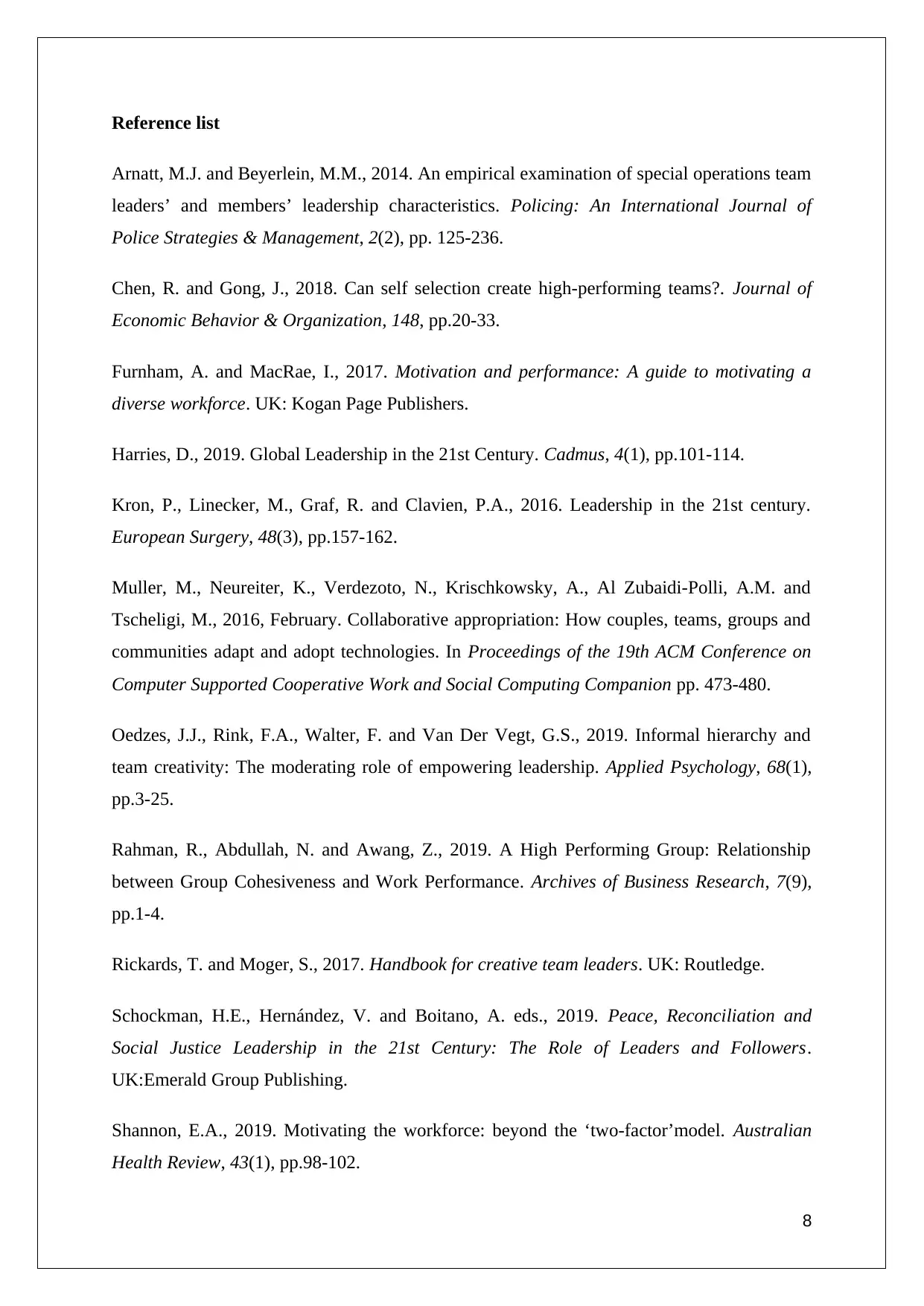
Reference list
Arnatt, M.J. and Beyerlein, M.M., 2014. An empirical examination of special operations team
leaders’ and members’ leadership characteristics. Policing: An International Journal of
Police Strategies & Management, 2(2), pp. 125-236.
Chen, R. and Gong, J., 2018. Can self selection create high-performing teams?. Journal of
Economic Behavior & Organization, 148, pp.20-33.
Furnham, A. and MacRae, I., 2017. Motivation and performance: A guide to motivating a
diverse workforce. UK: Kogan Page Publishers.
Harries, D., 2019. Global Leadership in the 21st Century. Cadmus, 4(1), pp.101-114.
Kron, P., Linecker, M., Graf, R. and Clavien, P.A., 2016. Leadership in the 21st century.
European Surgery, 48(3), pp.157-162.
Muller, M., Neureiter, K., Verdezoto, N., Krischkowsky, A., Al Zubaidi-Polli, A.M. and
Tscheligi, M., 2016, February. Collaborative appropriation: How couples, teams, groups and
communities adapt and adopt technologies. In Proceedings of the 19th ACM Conference on
Computer Supported Cooperative Work and Social Computing Companion pp. 473-480.
Oedzes, J.J., Rink, F.A., Walter, F. and Van Der Vegt, G.S., 2019. Informal hierarchy and
team creativity: The moderating role of empowering leadership. Applied Psychology, 68(1),
pp.3-25.
Rahman, R., Abdullah, N. and Awang, Z., 2019. A High Performing Group: Relationship
between Group Cohesiveness and Work Performance. Archives of Business Research, 7(9),
pp.1-4.
Rickards, T. and Moger, S., 2017. Handbook for creative team leaders. UK: Routledge.
Schockman, H.E., Hernández, V. and Boitano, A. eds., 2019. Peace, Reconciliation and
Social Justice Leadership in the 21st Century: The Role of Leaders and Followers.
UK:Emerald Group Publishing.
Shannon, E.A., 2019. Motivating the workforce: beyond the ‘two-factor’model. Australian
Health Review, 43(1), pp.98-102.
8
Arnatt, M.J. and Beyerlein, M.M., 2014. An empirical examination of special operations team
leaders’ and members’ leadership characteristics. Policing: An International Journal of
Police Strategies & Management, 2(2), pp. 125-236.
Chen, R. and Gong, J., 2018. Can self selection create high-performing teams?. Journal of
Economic Behavior & Organization, 148, pp.20-33.
Furnham, A. and MacRae, I., 2017. Motivation and performance: A guide to motivating a
diverse workforce. UK: Kogan Page Publishers.
Harries, D., 2019. Global Leadership in the 21st Century. Cadmus, 4(1), pp.101-114.
Kron, P., Linecker, M., Graf, R. and Clavien, P.A., 2016. Leadership in the 21st century.
European Surgery, 48(3), pp.157-162.
Muller, M., Neureiter, K., Verdezoto, N., Krischkowsky, A., Al Zubaidi-Polli, A.M. and
Tscheligi, M., 2016, February. Collaborative appropriation: How couples, teams, groups and
communities adapt and adopt technologies. In Proceedings of the 19th ACM Conference on
Computer Supported Cooperative Work and Social Computing Companion pp. 473-480.
Oedzes, J.J., Rink, F.A., Walter, F. and Van Der Vegt, G.S., 2019. Informal hierarchy and
team creativity: The moderating role of empowering leadership. Applied Psychology, 68(1),
pp.3-25.
Rahman, R., Abdullah, N. and Awang, Z., 2019. A High Performing Group: Relationship
between Group Cohesiveness and Work Performance. Archives of Business Research, 7(9),
pp.1-4.
Rickards, T. and Moger, S., 2017. Handbook for creative team leaders. UK: Routledge.
Schockman, H.E., Hernández, V. and Boitano, A. eds., 2019. Peace, Reconciliation and
Social Justice Leadership in the 21st Century: The Role of Leaders and Followers.
UK:Emerald Group Publishing.
Shannon, E.A., 2019. Motivating the workforce: beyond the ‘two-factor’model. Australian
Health Review, 43(1), pp.98-102.
8
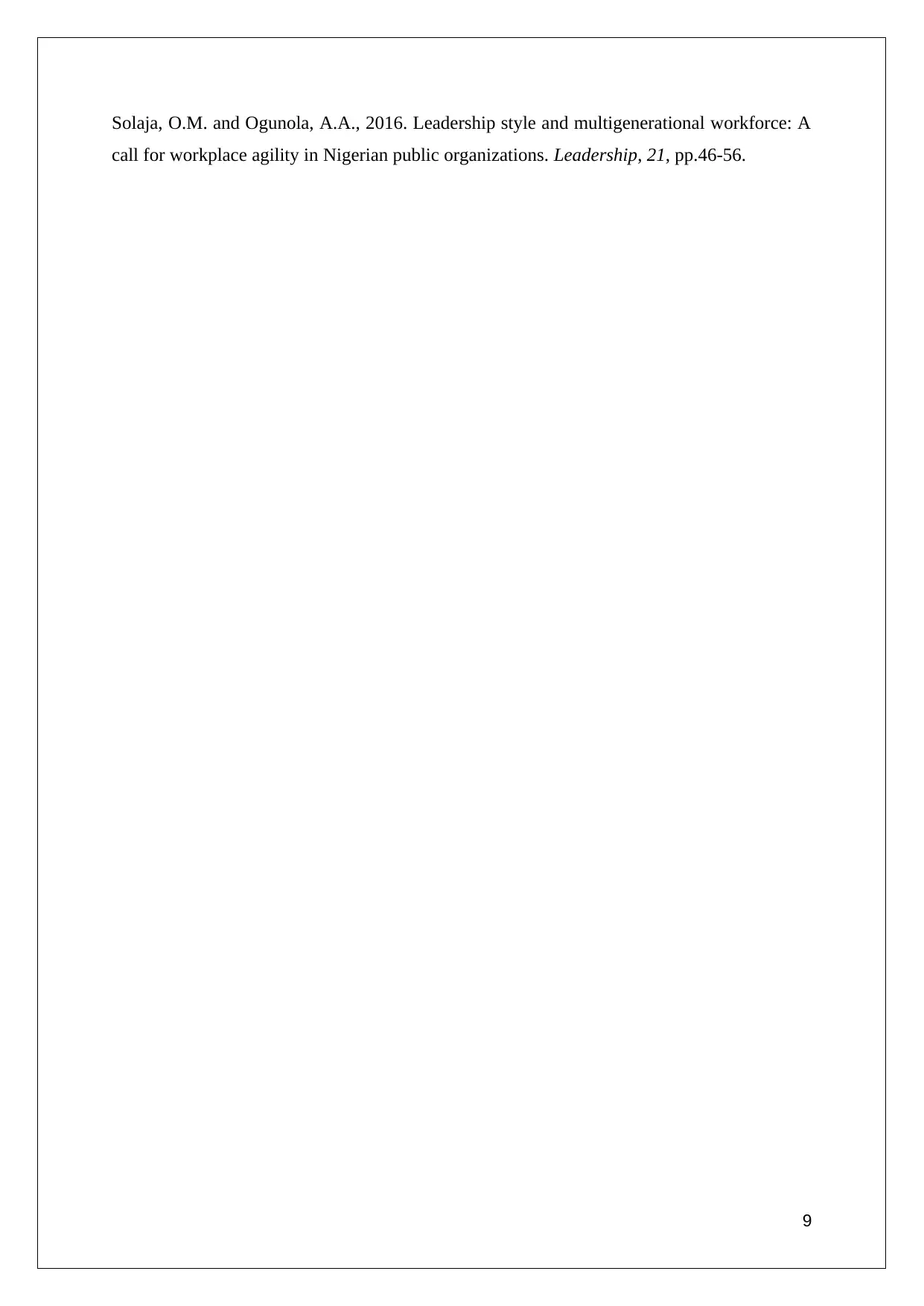
Solaja, O.M. and Ogunola, A.A., 2016. Leadership style and multigenerational workforce: A
call for workplace agility in Nigerian public organizations. Leadership, 21, pp.46-56.
9
call for workplace agility in Nigerian public organizations. Leadership, 21, pp.46-56.
9
⊘ This is a preview!⊘
Do you want full access?
Subscribe today to unlock all pages.

Trusted by 1+ million students worldwide
1 out of 9
Related Documents
Your All-in-One AI-Powered Toolkit for Academic Success.
+13062052269
info@desklib.com
Available 24*7 on WhatsApp / Email
![[object Object]](/_next/static/media/star-bottom.7253800d.svg)
Unlock your academic potential
Copyright © 2020–2025 A2Z Services. All Rights Reserved. Developed and managed by ZUCOL.





